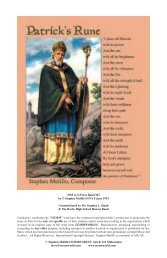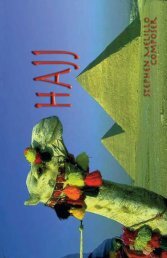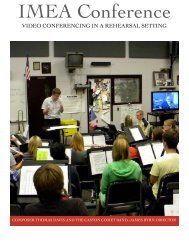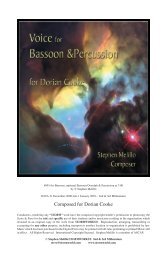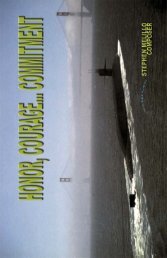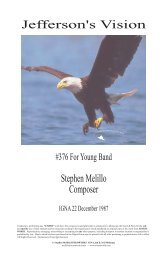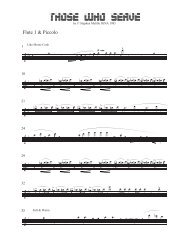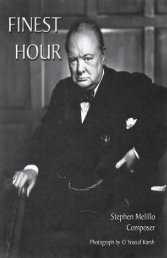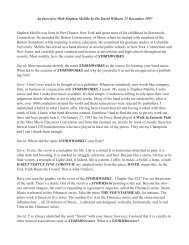STEPHEN MELILLO, COMPOSER<strong>STORMWORLD</strong>.COMConductors, render<strong>in</strong>g any “STORM” work have <strong>the</strong> composer/copyright holder’s permission tophotocopy <strong>the</strong> Score & Parts for <strong>the</strong> sole and specific use <strong>of</strong> <strong>the</strong>ir students and/or musiciansresid<strong>in</strong>g <strong>in</strong> <strong>the</strong> organization which <strong>in</strong>vested <strong>in</strong> an orig<strong>in</strong>al copy <strong>of</strong> <strong>the</strong> work from STORMWORKS®.Reproduction, arrang<strong>in</strong>g, transcrib<strong>in</strong>g or excerpt<strong>in</strong>g for any o<strong>the</strong>r purpose, <strong>in</strong>clud<strong>in</strong>g transportto ano<strong>the</strong>r location or organization is prohibited by law. Music which has been purchased <strong>in</strong> <strong>the</strong>Digital Form may be pr<strong>in</strong>ted with all rules perta<strong>in</strong><strong>in</strong>g to pr<strong>in</strong>ted Music still <strong>in</strong> effect. All RightsReserved. International Copyright Secured. Stephen Melillo is a member <strong>of</strong> ASCAP.© Stephen Melillo/STORMWORKS® 2nd & 3rd Millenniumwww.stormworld.comDear Conductor... Thank you for believ<strong>in</strong>g <strong>in</strong>, and <strong>in</strong>vest<strong>in</strong>g <strong>in</strong> <strong>the</strong> body <strong>of</strong> work called STORMWORKS. Once you’vetasted <strong>the</strong> possibilities and experienced <strong>the</strong> reactions from your students and audiences, a large body <strong>of</strong> <strong>in</strong>terrelated workawaits you. If you’ve <strong>in</strong>vested <strong>in</strong> <strong>the</strong> whole package or Suite... Bravo. It was <strong>the</strong> best way to go. The STORMSite atwww.stormworld.com provides up-to-date <strong>in</strong>fo on all that is happen<strong>in</strong>g with STORMWORKS ® . Thanks so much forchampion<strong>in</strong>g this Music and Godspeed <strong>in</strong> <strong>the</strong> journeys ahead.SYSTEM REQUIREMENTSOne wouldn’t th<strong>in</strong>k <strong>of</strong> buy<strong>in</strong>g s<strong>of</strong>tware without hav<strong>in</strong>g <strong>the</strong> appropriate hardware. With this same common-sense th<strong>in</strong>k<strong>in</strong>g,conductors render<strong>in</strong>g “Storm” Works should be properly equipped.In <strong>the</strong> Band <strong>of</strong> <strong>the</strong> 3rd Millennium, <strong>the</strong> orchestration employed <strong>in</strong> <strong>the</strong> body <strong>of</strong> work called Stormworks, we f<strong>in</strong>d <strong>the</strong>standard w<strong>in</strong>d and percussion ensemble augmented by <strong>the</strong> use <strong>of</strong> 2 syn<strong>the</strong>sizers. A seem<strong>in</strong>gly <strong>in</strong>nocent leap, it is repletewith functionality. The generic sounds ascribed to <strong>the</strong> syn<strong>the</strong>sizers are: PAD Bass, (sometimes Piano and/or Chorus)and Harp. Comments about <strong>the</strong> types <strong>of</strong> sounds and manner <strong>of</strong> <strong>in</strong>terpret<strong>in</strong>g <strong>the</strong> varied notation may be found <strong>in</strong> <strong>the</strong> BriefIntro to <strong>the</strong> Music <strong>of</strong> Stephen Melillo... with FAQs resid<strong>in</strong>g on <strong>the</strong> STORMSite at stormworld.com.In 1980, <strong>the</strong> cost for such an undertak<strong>in</strong>g was significant. Now, for a cost-effective, multi-useful <strong>in</strong>vestment, yourprogram can be readily equipped. Of course, this is only if you are completely un-equipped right now! Most musicprograms will have at least one student who owns a syn<strong>the</strong>sizer, or at least knows someone who does. In <strong>the</strong> early 1980s,I was able to recruit a great number <strong>of</strong> students simply by suggest<strong>in</strong>g that <strong>the</strong>re was a place for <strong>the</strong>m <strong>in</strong> <strong>the</strong> “electronics”section! I <strong>in</strong>vite you, now with Music that calls for it, to be champions <strong>of</strong> a wider and fuller Music Education.On <strong>the</strong> STORMWORKS CDs, you will hear how <strong>the</strong>se sounds, placed <strong>in</strong> a stereo field around <strong>the</strong> band... as <strong>in</strong> <strong>the</strong>diagram on <strong>the</strong> seat<strong>in</strong>g chart page... enhances <strong>the</strong> overtone hierarchy and resonance <strong>of</strong> <strong>the</strong> band while rema<strong>in</strong><strong>in</strong>gsomewhat “traditional” <strong>in</strong> its orchestral usage. Two speakers, ly<strong>in</strong>g flat on <strong>the</strong> floor, should be placed so that <strong>the</strong> soundis directed back <strong>in</strong>to <strong>the</strong> ensemble.As we approach all <strong>of</strong> <strong>the</strong> new tomorrows, students need to play Music, that while serv<strong>in</strong>g <strong>the</strong> cause and purpose <strong>of</strong>Music Education, excites <strong>the</strong>m... Music which sonically competes with <strong>the</strong> <strong>in</strong>undation <strong>of</strong> supremely produced sounds<strong>the</strong>y hear <strong>in</strong> <strong>the</strong>ir every day lives.A vast variety <strong>of</strong> <strong>in</strong>terrelated and graduated pieces as well as accompany<strong>in</strong>g Teach<strong>in</strong>g Tools await you.Now, as always, it’s up to you. Only you can be <strong>the</strong> guide your students need, and only you can deliver this Music to thatlimitless realm we refer to as Music. To that Quest, noble and honorable, Godspeed!∕¤‹›Stephen Melillo, Composer
Chapter 13STORMQUEST<strong>By</strong> <strong>Love</strong> <strong>Compelled</strong>... <strong>in</strong> <strong>the</strong> <strong>Hour</strong> <strong>of</strong> <strong>Shadows</strong>#835 at 5:00 by © Stephen Melillo IGNA 15 January 1997Commissioned by <strong>the</strong> Anoka High School Concert BandJohn Lace, DirectorDedicated “to those who believe that Light will always follow <strong>the</strong> darkness!”TECHNICALYour kids can play this piece... well!This piece, as do all pieces, calls for careful balanc<strong>in</strong>g and tun<strong>in</strong>g. The range <strong>of</strong> this piece falls with<strong>in</strong> a grade 2-3work for younger band with some options <strong>in</strong>dicated <strong>in</strong> <strong>the</strong> score and parts. The second clar<strong>in</strong>ets stay below <strong>the</strong> break,and <strong>the</strong> orchestration stays with<strong>in</strong> <strong>the</strong> somewhat normal and expected parameters <strong>of</strong> <strong>the</strong> “young” band. There aresome deviations, however. These reside <strong>in</strong> <strong>the</strong> notes employed and sometimes a request for an ever-reach<strong>in</strong>g range.There’s noth<strong>in</strong>g so om<strong>in</strong>ous about a Gb... it’s just ano<strong>the</strong>r note to be learned. Approach <strong>the</strong> piece that way. Look at itsvocabulary, determ<strong>in</strong>e <strong>the</strong> notes <strong>the</strong> kids will need to know, troubleshoot first and <strong>the</strong>n enjoy <strong>the</strong> piece. Remember myfavorite quote from Abraham L<strong>in</strong>coln. “If I had 8 hours to chop down a tree, I’d spend six sharpen<strong>in</strong>g <strong>the</strong> axe.”The Musical demand, as always... exceeds any grad<strong>in</strong>g system.There is no difference <strong>in</strong> <strong>the</strong>se sounds and <strong>the</strong> sounds that would be written for pr<strong>of</strong>essional musicians. That is <strong>the</strong>whole approach to STORMQuest!The PAD Bass part should sound an octave below what is written. This adjustment can be made quite easily on anykeyboard or synth module. In <strong>By</strong> <strong>Love</strong> <strong>Compelled</strong>, <strong>the</strong> PAD Bass will also make a patch change to a choir sound.The sound <strong>of</strong> choice is <strong>the</strong> “Voices” on <strong>the</strong> Roland Super JX. The TREBLE CLEF <strong>in</strong>dicates <strong>the</strong> Vocal patch. TheBASS CLEF represents <strong>the</strong> PAD Bass. Please be sure to read “A BRIEF INTRO TO MELILLO MUSIC”. Theensemble <strong>of</strong> <strong>the</strong> new millennium requires an awareness <strong>of</strong>, and an appreciation for, <strong>the</strong> electronic component.I had thought about writ<strong>in</strong>g vocal cues for <strong>the</strong> w<strong>in</strong>d musicians. Let me be candid. There are two reasons, I did not dothis, though I will always leave that additional option to you. 1. With few exceptions, I dislike band pieces that callfor s<strong>in</strong>g<strong>in</strong>g. 2. The written sound, with a properly chosen and balanced synth sound, will create a wonderful and newtexture <strong>in</strong> our ensemble <strong>of</strong> <strong>the</strong> new millennium. I promise you <strong>the</strong> love <strong>of</strong> your audience! Be brave and stay with me.Between measures 9 and 15, a number <strong>of</strong> th<strong>in</strong>gs happen. First... <strong>the</strong>re is no time. The w<strong>in</strong>d players will hit a cluster<strong>of</strong> sound. It should rema<strong>in</strong> very quiet... sp<strong>in</strong>e-chill<strong>in</strong>gly quiet! Now, here are <strong>the</strong> follow<strong>in</strong>g sub-groups <strong>in</strong> <strong>the</strong> cluster.1. Flute 1-2, Oboe & Bassoon2. Clar<strong>in</strong>et 1-2 & Bass Clar<strong>in</strong>et3. Saxophones4. Horns5. Trumpets6. Low BrassDevelop an <strong>in</strong>dication for each <strong>of</strong> <strong>the</strong>se sub-groups. Then through signal<strong>in</strong>g, make each section swell and fadethrough <strong>the</strong> texture. Depend<strong>in</strong>g on how your band is set, you can also pass through <strong>the</strong> rows with dynamic swells.You can also devise your own creative “play<strong>in</strong>g” with <strong>the</strong> textures once you are familiar with <strong>the</strong> resultant colours andeffects.On <strong>the</strong> score you will note <strong>the</strong> <strong>in</strong>dication, “Special Percussion Effects”. Here’s what you need to elicit from <strong>the</strong> kids.(On next page.)



